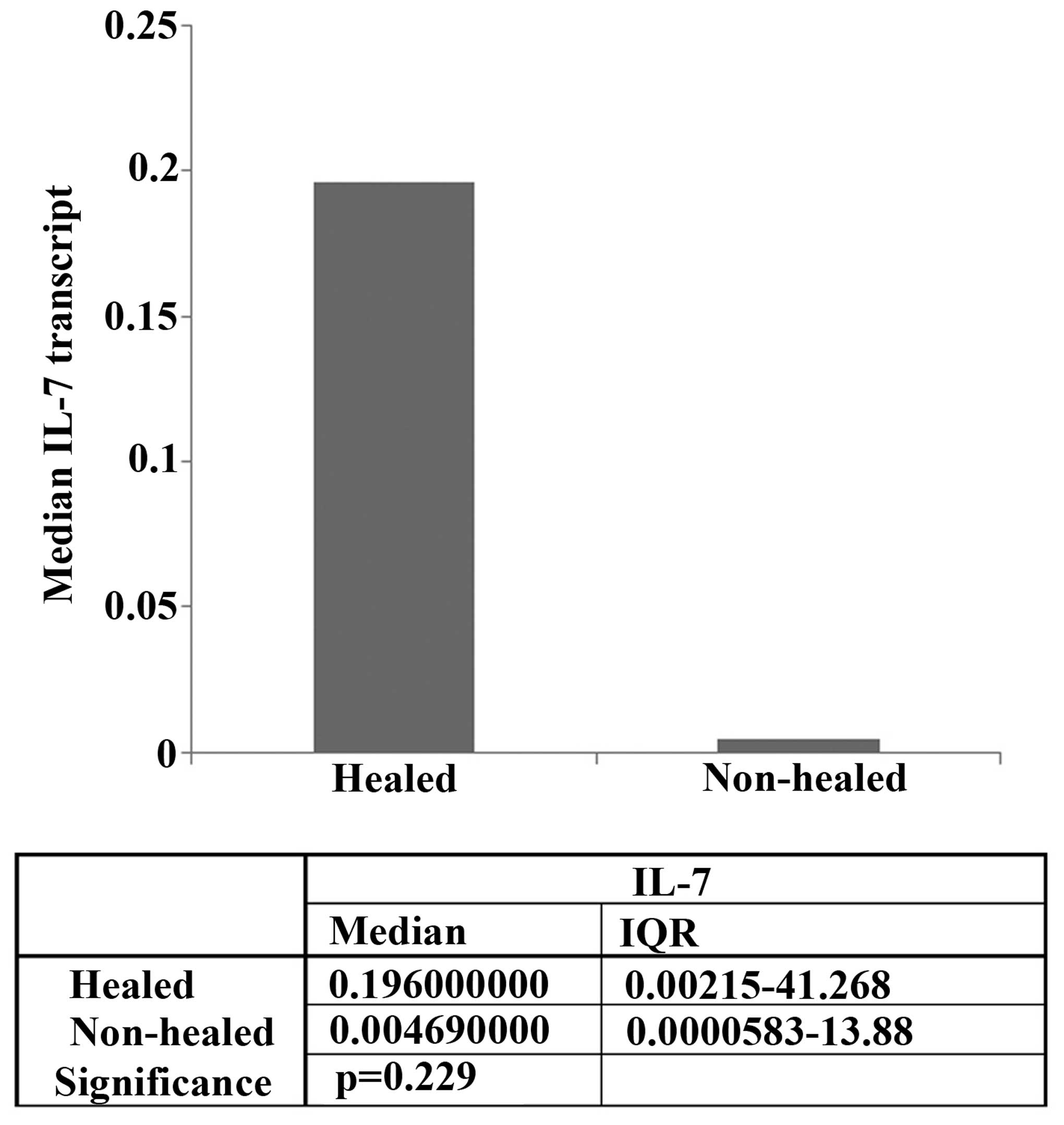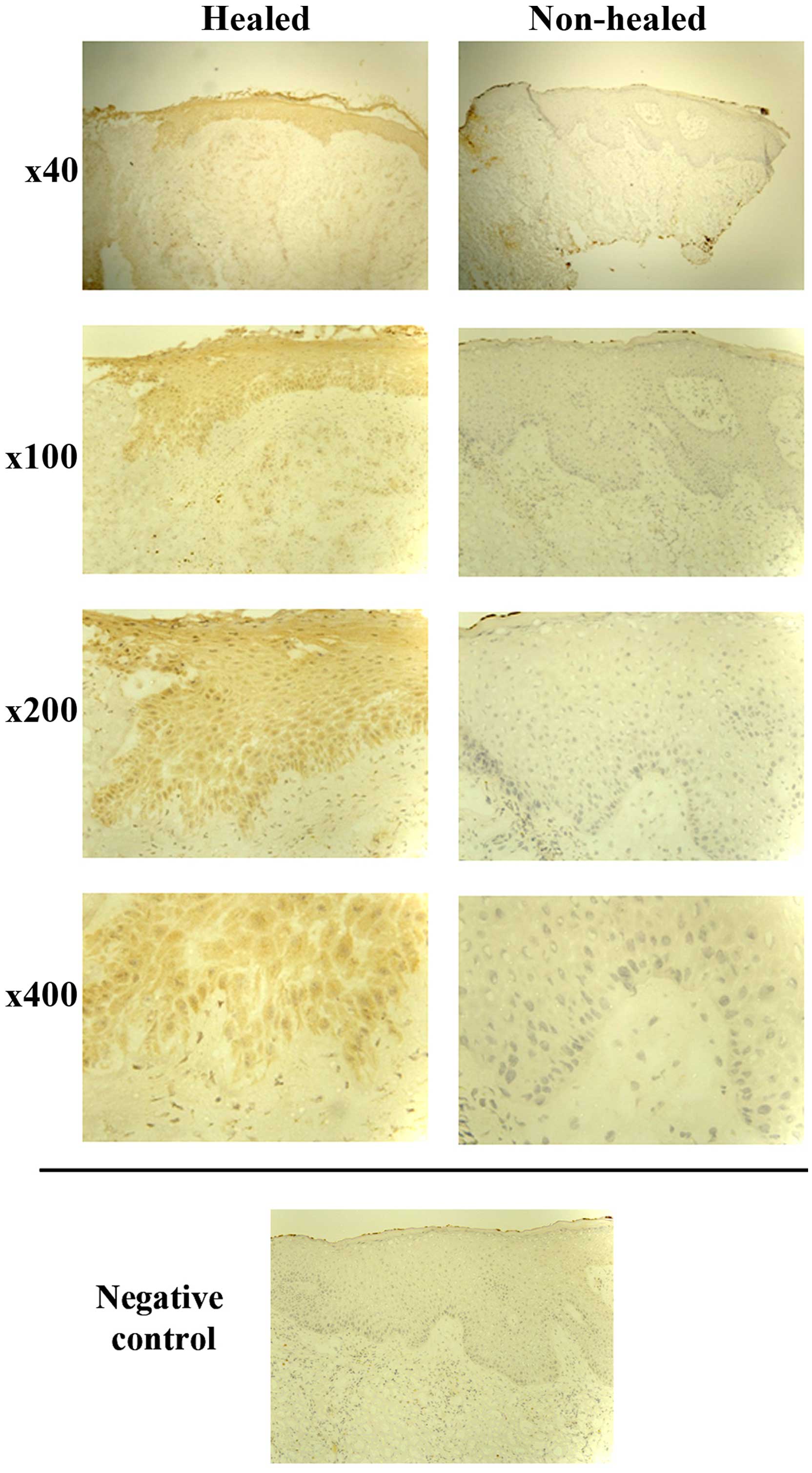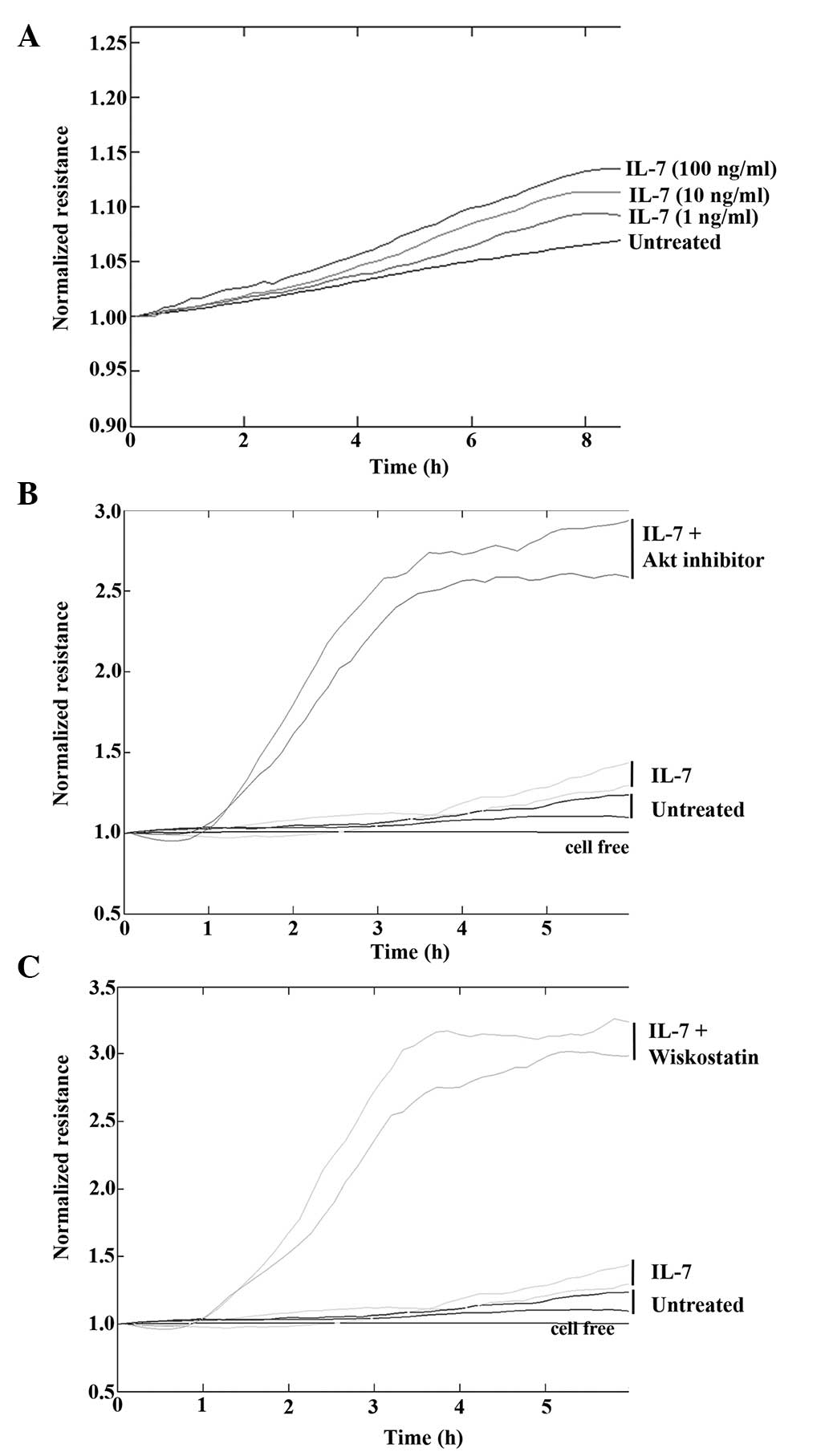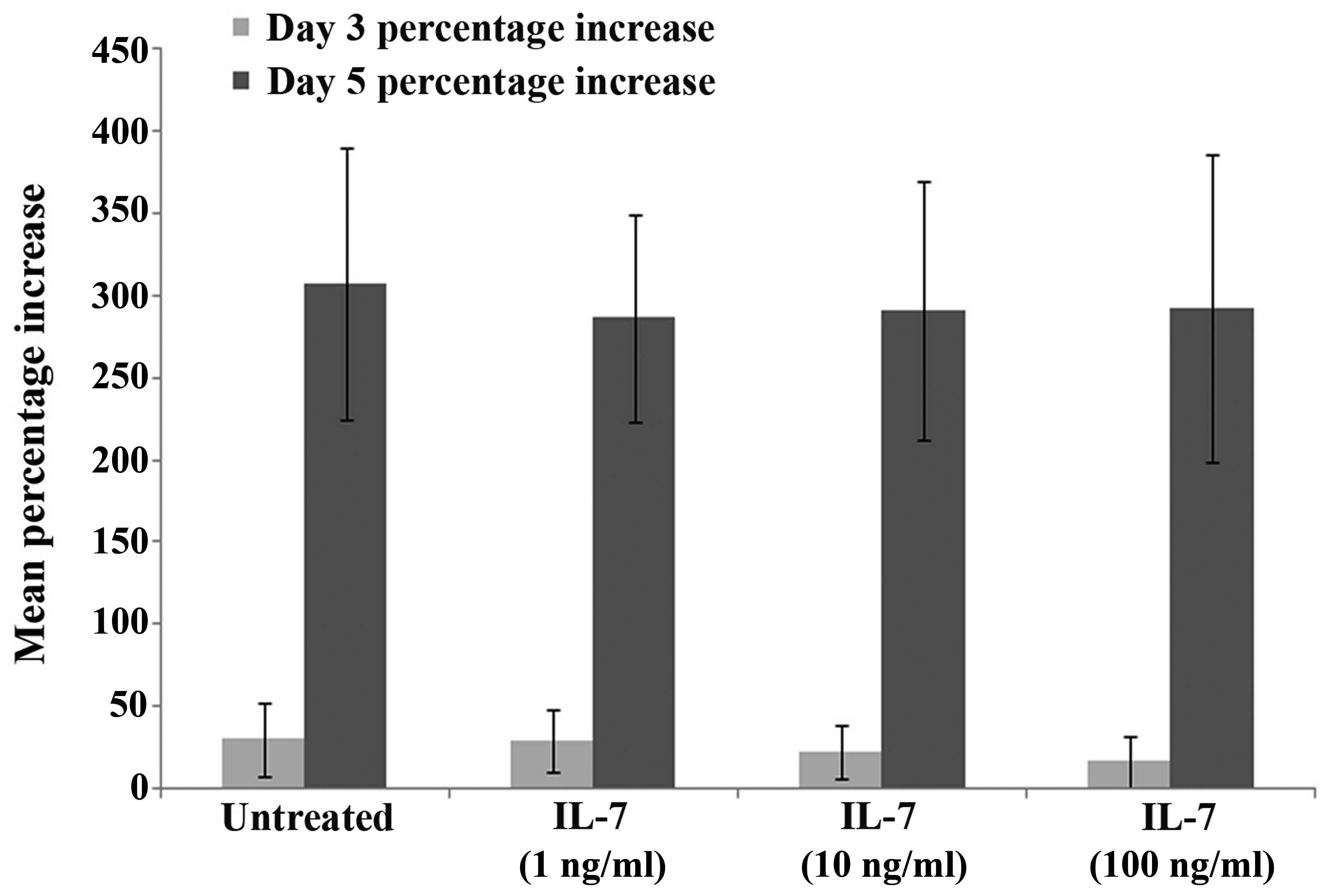|
1
|
Behm B, Babilas P, Landthaler M and
Schreml S: Cytokines, chemokines and growth factors in wound
healing. J Eur Acad Dermatol Venereol. 26:812–820. 2012. View Article : Google Scholar : PubMed/NCBI
|
|
2
|
Werdin F, Tennenhaus M, Schaller HE and
Rennekampff HO: Evidence-based management strategies for treatment
of chronic wounds. Eplasty. 9:e192009.PubMed/NCBI
|
|
3
|
Demidova-Rice TN, Hamblin MR and Herman
IM: Acute and impaired wound healing: Pathophysiology and current
methods for drug delivery, part 2: Role of growth factors in normal
and pathological wound healing: Therapeutic potential and methods
of delivery. Adv Skin Wound Care. 25:349–370. 2012. View Article : Google Scholar : PubMed/NCBI
|
|
4
|
Thomas DW and Harding KG: Wound healing.
Br J Surg. 89:1203–1205. 2002. View Article : Google Scholar : PubMed/NCBI
|
|
5
|
Namen AE, Schmierer AE, March CJ, Overell
RW, Park LS, Urdal DL and Mochizuki DY: B cell precursor
growth-promoting activity. Purification and characterization of a
growth factor active on lymphocyte precursors. J Exp Med.
167:988–1002. 1988. View Article : Google Scholar : PubMed/NCBI
|
|
6
|
Heufler C, Topar G, Grasseger A, Stanzl U,
Koch F, Romani N, Namen AE and Schuler G: Interleukin 7 is produced
by murine and human keratinocytes. J Exp Med. 178:1109–1114. 1993.
View Article : Google Scholar : PubMed/NCBI
|
|
7
|
Goodwin RG, Lupton S, Schmierer A,
Hjerrild KJ, Jerzy R, Clevenger W, Gillis S, Cosman D and Namen AE:
Human interleukin 7: Molecular cloning and growth factor activity
on human and murine B-lineage cells. Proc Natl Acad Sci USA.
86:302–306. 1989. View Article : Google Scholar : PubMed/NCBI
|
|
8
|
Namen AE, Lupton S, Hjerrild K, Wignall J,
Mochizuki DY, Schmierer A, Mosley B, March CJ, Urdal D and Gillis
S: Stimulation of B-cell progenitors by cloned murine
interleukin-7. Nature. 333:571–573. 1988. View Article : Google Scholar : PubMed/NCBI
|
|
9
|
Sakata T, Iwagami S, Tsuruta Y, Teraoka H,
Tatsumi Y, Kita Y, Nishikawa S, Takai Y and Fujiwara H:
Constitutive expression of interleukin-7 mRNA and production of
IL-7 by a cloned murine thymic stromal cell line. J Leukoc Biol.
48:205–212. 1990.PubMed/NCBI
|
|
10
|
Watson JD, Morrissey PJ, Namen AE, Conlon
PJ and Widmer MB: Effect of IL-7 on the growth of fetal thymocytes
in culture. J Immunol. 143:1215–1222. 1989.PubMed/NCBI
|
|
11
|
Murray R, Suda T, Wrighton N, Lee F and
Zlotnik A: IL-7 is a growth and maintenance factor for mature and
immature thymocyte subsets. Int Immunol. 1:526–531. 1989.
View Article : Google Scholar : PubMed/NCBI
|
|
12
|
Wolf SS and Cohen A: Expression of
cytokines and their receptors by human thymocytes and thymic
stromal cells. Immunology. 77:362–368. 1992.PubMed/NCBI
|
|
13
|
Grabstein KH, Namen AE, Shanebeck K, Voice
RF, Reed SG and Widmer MB: Regulation of T cell proliferation by
IL-7. J Immunol. 144:3015–3020. 1990.PubMed/NCBI
|
|
14
|
Uckun FM, Tuel-Ahlgren L, Obuz V, Smith R,
Dibirdik I, Hanson M, Langlie MC and Ledbetter JA: Interleukin 7
receptor engagement stimulates tyrosine phosphorylation, inositol
phospholipid turnover, proliferation and selective differentiation
to the CD4 lineage by human fetal thymocytes. Proc Natl Acad Sci
USA. 88:6323–6327. 1991. View Article : Google Scholar : PubMed/NCBI
|
|
15
|
Chazen GD, Pereira GM, LeGros G, Gillis S
and Shevach EM: Interleukin 7 is a T-cell growth factor. Proc Natl
Acad Sci USA. 86:5923–5927. 1989. View Article : Google Scholar : PubMed/NCBI
|
|
16
|
Londei M, Verhoef A, Hawrylowicz C, Groves
J, De Berardinis P and Feldmann M: Interleukin 7 is a growth factor
for mature human T cells. Eur J Immunol. 20:425–428. 1990.
View Article : Google Scholar : PubMed/NCBI
|
|
17
|
Simonetta F, Gestermann N, Martinet KZ,
Boniotto M, Tissières P, Seddon B and Bourgeois C: Interleukin-7
influences FOXP3+CD4+ regulatory T cells peripheral homeostasis.
PloS One. 7:e365962012. View Article : Google Scholar : PubMed/NCBI
|
|
18
|
Watanabe M, Ueno Y, Yajima T, Iwao Y,
Tsuchiya M, Ishikawa H, Aiso S, Hibi T and Ishii H: Interleukin 7
is produced by human intestinal epithelial cells and regulates the
proliferation of intestinal mucosal lymphocytes. J Clin Invest.
95:2945–2953. 1995. View Article : Google Scholar : PubMed/NCBI
|
|
19
|
Al-Rawi MA, Rmali K, Watkins G, Mansel RE
and Jiang WG: Aberrant expression of interleukin-7 (IL-7) and its
signalling complex in human breast cancer. Eur J Cancer.
40:494–502. 2004. View Article : Google Scholar : PubMed/NCBI
|
|
20
|
Dalloul A, Laroche L, Bagot M, Mossalayi
MD, Fourcade C, Thacker DJ, Hogge DE, Merle-Béral H, Debré P and
Schmitt C: Interleukin-7 is a growth factor for Sézary lymphoma
cells. J Clin Invest. 90:1054–1060. 1992. View Article : Google Scholar : PubMed/NCBI
|
|
21
|
Goodwin RG, Friend D, Ziegler SF, Jerzy R,
Falk BA, Gimpel S, Cosman D, Dower SK, March CJ and Namen AE:
Cloning of the human and murine interleukin-7 receptors:
Demonstration of a soluble form and homology to a new receptor
superfamily. Cell. 60:941–951. 1990. View Article : Google Scholar : PubMed/NCBI
|
|
22
|
Ziegler SE, Morella KK, Anderson D, Kumaki
N, Leonard WJ, Cosman D and Baumann H: Reconstitution of a
functional interleukin (IL)-7 receptor demonstrates that the IL-2
receptor gamma chain is required for IL-7 signal transduction. Eur
J Immunol. 25:399–404. 1995. View Article : Google Scholar : PubMed/NCBI
|
|
23
|
Quentmeier H, Drexler HG, Fleckenstein D,
Zaborski M, Armstrong A, Sims JE and Lyman SD: Cloning of human
thymic stromal lymphopoietin (TSLP) and signaling mechanisms
leading to proliferation. Leukemia. 15:1286–1292. 2001. View Article : Google Scholar : PubMed/NCBI
|
|
24
|
Pandey A, Ozaki K, Baumann H, Levin SD,
Puel A, Farr AG, Ziegler SF, Leonard WJ and Lodish HF: Cloning of a
receptor subunit required for signaling by thymic stromal
lymphopoietin. Nat Immunol. 1:59–64. 2000. View Article : Google Scholar : PubMed/NCBI
|
|
25
|
Kondo M, Takeshita T, Higuchi M, Nakamura
M, Sudo T, Nishikawa S and Sugamura K: Functional participation of
the IL-2 receptor gamma chain in IL-7 receptor complexes. Science.
263:1453–1454. 1994. View Article : Google Scholar : PubMed/NCBI
|
|
26
|
Russell SM, Keegan AD, Harada N, Nakamura
Y, Noguchi M, Leland P, Friedmann MC, Miyajima A, Puri RK and Paul
WE: Interleukin-2 receptor gamma chain: A functional component of
the interleukin-4 receptor. Science. 262:1880–1883. 1993.
View Article : Google Scholar : PubMed/NCBI
|
|
27
|
Kimura Y, Takeshita T, Kondo M, Ishii N,
Nakamura M, Van Snick J and Sugamura K: Sharing of the IL-2
receptor gamma chain with the functional IL-9 receptor complex. Int
Immunol. 7:115–120. 1995. View Article : Google Scholar : PubMed/NCBI
|
|
28
|
Anderson DM, Kumaki S, Ahdieh M, Bertles
J, Tometsko M, Loomis A, Giri J, Copeland NG, Gilbert DJ and
Jenkins NA: Functional characterization of the human interleukin-15
receptor alpha chain and close linkage of IL15RA and IL2RA genes. J
Biol Chem. 270:29862–29869. 1995. View Article : Google Scholar : PubMed/NCBI
|
|
29
|
Dus D, Krawczenko A, Załecki P, Paprocka
M, Wiedłocha A, Goupille C and Kieda C: IL-7 receptor is present on
human microvascular endothelial cells. Immunol Lett. 86:163–168.
2003. View Article : Google Scholar : PubMed/NCBI
|
|
30
|
Cosenza L, Gorgun G, Urbano A and Foss F:
Interleukin-7 receptor expression and activation in
nonhaematopoietic neoplastic cell lines. Cell Signal. 14:317–325.
2002. View Article : Google Scholar : PubMed/NCBI
|
|
31
|
Foxwell BM, Beadling C, Guschin D, Kerr I
and Cantrell D: Interleukin-7 can induce the activation of Jak 1,
Jak 3 and STAT 5 proteins in murine T cells. Eur J Immunol.
25:3041–3046. 1995. View Article : Google Scholar : PubMed/NCBI
|
|
32
|
Pallard C, Stegmann AP, van Kleffens T,
Smart F, Venkitaraman A and Spits H: Distinct roles of the
phosphatidylinositol 3-kinase and STAT5 pathways in IL-7-mediated
development of human thymocyte precursors. Immunity. 10:525–535.
1999. View Article : Google Scholar : PubMed/NCBI
|
|
33
|
Mazzucchelli R and Durum SK: Interleukin-7
receptor expression: Intelligent design. Nat Rev Immunol.
7:144–154. 2007. View Article : Google Scholar : PubMed/NCBI
|
|
34
|
Li WQ, Jiang Q, Khaled AR, Keller JR and
Durum SK: Interleukin-7 inactivates the pro-apoptotic protein Bad
promoting T cell survival. J Biol Chem. 279:29160–29166. 2004.
View Article : Google Scholar : PubMed/NCBI
|
|
35
|
Dadi HK and Roifman CM: Activation of
phosphatidylinositol-3 kinase by ligation of the interleukin-7
receptor on human thymocytes. J Clin Invest. 92:1559–1563. 1993.
View Article : Google Scholar : PubMed/NCBI
|
|
36
|
Rich BE, Campos-Torres J, Tepper RI,
Moreadith RW and Leder P: Cutaneous lymphoproliferation and
lymphomas in interleukin 7 transgenic mice. J Exp Med. 177:305–316.
1993. View Article : Google Scholar : PubMed/NCBI
|
|
37
|
Touw I, Pouwels K, van Agthoven T, van
Gurp R, Budel L, Hoogerbrugge H, Delwel R, Goodwin R, Namen A and
Löwenberg B: Interleukin-7 is a growth factor of precursor B and T
acute lymphoblastic leukemia. Blood. 75:2097–2101. 1990.PubMed/NCBI
|
|
38
|
Eder M, Ottmann OG, Hansen-Hagge TE,
Bartram CR, Gillis S, Hoelzer D and Ganser A: Effects of
recombinant human IL-7 on blast cell proliferation in acute
lymphoblastic leukemia. Leukemia. 4:533–540. 1990.PubMed/NCBI
|
|
39
|
Sasson SC, Smith S, Seddiki N, Zaunders
JJ, Bryant A, Koelsch KK, Weatherall C, Munier ML, McGinley C,
Yeung J, et al: IL-7 receptor is expressed on adult pre-B-cell
acute lymphoblastic leukemia and other B-cell derived neoplasms and
correlates with expression of proliferation and survival markers.
Cytokine. 50:58–68. 2010. View Article : Google Scholar : PubMed/NCBI
|
|
40
|
Foss FM, Koc Y, Stetler-Stevenson MA,
Nguyen DT, O'Brien MC, Turner R and Sausville EA: Costimulation of
cutaneous T-cell lymphoma cells by interleukin-7 and interleukin-2:
Potential autocrine or paracrine effectors in the Sézary syndrome.
J Clin Oncol. 12:326–335. 1994.PubMed/NCBI
|
|
41
|
Qin JZ, Zhang CL, Kamarashev J, Dummer R,
Burg G and Dobbeling U: Interleukin-7 and interleukin-15 regulate
the expression of the bcl-2 and c-myb genes in cutaneous T-cell
lymphoma cells. Blood. 98:2778–2783. 2001. View Article : Google Scholar : PubMed/NCBI
|
|
42
|
Foss HD, Hummel M, Gottstein S, Ziemann K,
Falini B, Herbst H and Stein H: Frequent expression of IL-7 gene
transcripts in tumor cells of classical Hodgkin's disease. Am J
Pathol. 146:33–39. 1995.PubMed/NCBI
|
|
43
|
Digel W, Schmid M, Heil G, Conrad P,
Gillis S and Porzsolt F: Human interleukin-7 induces proliferation
of neoplastic cells from chronic lymphocytic leukemia and acute
leukemias. Blood. 78:753–759. 1991.PubMed/NCBI
|
|
44
|
Yoshioka R, Shimizu S, Tachibana J, Hirose
Y, Fukutoku M, Takeuchi Y, Sugai S, Takiguchi T and Konda S:
Interleukin-7 (IL-7)-induced proliferation of CD8+ T-chronic
lymphocytic leukemia cells. J Clin Immunol. 12:101–106. 1992.
View Article : Google Scholar : PubMed/NCBI
|
|
45
|
Takeuchi T, Yamanouchi H, Yue Q and
Ohtsuki Y: Epithelial component of lymphoid stroma-rich Warthin's
tumour expresses interleukin (IL)-7. Histopathology. 32:383–384.
1998. View Article : Google Scholar : PubMed/NCBI
|
|
46
|
Paleri V, Pulimood A, Davies GR and
Birchall MA: Interleukins 7 and 12 are expressed in head and neck
squamous cancer. Clin Otolaryngol Allied Sci. 26:302–306. 2001.
View Article : Google Scholar : PubMed/NCBI
|
|
47
|
Trinder P, Seitzer U, Gerdes J, Seliger B
and Maeurer M: Constitutive and IFN-gamma regulated expression of
IL-7 and IL-15 in human renal cell cancer. Int J Oncol. 14:23–31.
1999.PubMed/NCBI
|
|
48
|
Oka M, Hirose K, Iizuka N, Aoyagi K,
Yamamoto K, Abe T, Hazama S and Suzuki T: Cytokine mRNA expression
patterns in human esophageal cancer cell lines. J Interferon
Cytokine Res. 15:1005–1009. 1995. View Article : Google Scholar : PubMed/NCBI
|
|
49
|
Maeurer MJ, Walter W, Martin D, Zitvogel
L, Elder E, Storkus W and Lotze MT: Interleukin-7 (IL-7) in
colorectal cancer: IL-7 is produced by tissues from colorectal
cancer and promotes preferential expansion of tumour infiltrating
lymphocytes. Scand J Immunol. 45:182–192. 1997. View Article : Google Scholar : PubMed/NCBI
|
|
50
|
Al-Rawi MA, Rmali K, Mansel RE and Jiang
WG: Interleukin 7 induces the growth of breast cancer cells through
a wortmannin-sensitive pathway. Br J Surg. 91:61–68. 2004.
View Article : Google Scholar : PubMed/NCBI
|
|
51
|
Al-Rawi MA, Watkins G, Mansel RE and Jiang
WG: The effects of interleukin-7 on the lymphangiogenic properties
of human endothelial cells. Int J Oncol. 27:721–730.
2005.PubMed/NCBI
|
|
52
|
Al-Rawi MA, Watkins G, Mansel RE and Jiang
WG: Interleukin 7 upregulates vascular endothelial growth factor D
in breast cancer cells and induces lymphangiogenesis in vivo. Br J
Surg. 92:305–310. 2005. View Article : Google Scholar : PubMed/NCBI
|
|
53
|
Ming J, Zhang Q, Qiu X and Wang E:
Interleukin 7/interleukin 7 receptor induce c-Fos/c-Jun-dependent
vascular endothelial growth factor-D up-regulation: A mechanism of
lymphangiogenesis in lung cancer. Eur J Cancer. 45:866–873. 2009.
View Article : Google Scholar : PubMed/NCBI
|
|
54
|
Ming J, Zhang Q, Jiang Y, Qiu X and Bai X:
The expressions of IL-7 and IL-7R and the relationship between them
with lymph node metastasis and prognosis in non-small cell lung
cancer. Zhongguo Fei Ai Za Zhi. 13:1101–1106. 2010.(In Chinese).
PubMed/NCBI
|
|
55
|
Ming J, Jiang G, Zhang Q, Qiu X and Wang
E: Interleukin-7 up-regulates cyclin D1 via activator protein-1 to
promote proliferation of cell in lung cancer. Cancer Immunol
Immunother. 61:79–88. 2012. View Article : Google Scholar : PubMed/NCBI
|
|
56
|
Matsue H, Bergstresser PR and Takashima A:
Keratinocyte-derived IL-7 serves as a growth factor for dendritic
epidermal T cells in mice. J Immunol. 151:6012–6019.
1993.PubMed/NCBI
|
|
57
|
Takashima A, Matsue H, Bergstresser PR and
Ariizumi K: Interleukin-7-dependent interaction of dendritic
epidermal T cells with keratinocytes. J Invest Dermatol. 105(1
Suppl): 50S–53S. 1995. View Article : Google Scholar : PubMed/NCBI
|
|
58
|
Giacalone B, D'Auria L, Bonifati C,
Ferraro C, Riccardi E, Mussi A, D'Agosto G, Cordiali-Fei P and
Ameglio F: Decreased interleukin-7 and transforming growth
factor-beta1 levels in blister fluids as compared to the respective
serum levels in patients with bullous pemphigoid. Opposite behavior
of TNF-alpha, interleukin-4 and interleukin-10. Exp Dermatol.
7:157–161. 1998. View Article : Google Scholar : PubMed/NCBI
|
|
59
|
Balkwill F and Mantovani A: Inflammation
and cancer: Back to Virchow? Lancet. 357:539–545. 2001. View Article : Google Scholar : PubMed/NCBI
|
|
60
|
Dvorak HF: Tumors: Wounds that do not
heal. Similarities between tumor stroma generation and wound
healing. N Engl J Med. 315:1650–1659. 1986. View Article : Google Scholar : PubMed/NCBI
|
|
61
|
Bosanquet DC, Harding KG, Ruge F, Sanders
AJ and Jiang WG: Expression of IL-24 and IL-24 receptors in human
wound tissues and the biological implications of IL-24 on
keratinocytes. Wound Repair Regen. 20:896–903. 2012. View Article : Google Scholar : PubMed/NCBI
|
|
62
|
Jiang WG, Sanders AJ, Ruge F and Harding
KG: Influence of interleukin-8 (IL-8) and IL-8 receptors on the
migration of human keratinocytes, the role of PLC-γ and potential
clinical implications. Exp Ther Med. 3:231–236. 2012.PubMed/NCBI
|
|
63
|
Jiang WG, Martin TA, Lewis-Russell JM,
Douglas-Jones A, Ye L and Mansel RE: Eplin-alpha expression in
human breast cancer, the impact on cellular migration and clinical
outcome. Mol Cancer. 7:712008. View Article : Google Scholar : PubMed/NCBI
|
|
64
|
Palagummi S, Harbison S and Fleming R: A
time-course analysis of mRNA expression during injury healing in
human dermal injuries. Int J Legal Med. 128:403–414. 2014.
View Article : Google Scholar : PubMed/NCBI
|
|
65
|
Kandel ES and Hay N: The regulation and
activities of the multifunctional serine/threonine kinase Akt/PKB.
Exp Cell Res. 253:210–229. 1999. View Article : Google Scholar : PubMed/NCBI
|
|
66
|
Grille SJ, Bellacosa A, Upson J,
Klein-Szanto AJ, van Roy F, Lee-Kwon W, Donowitz M, Tsichlis PN and
Larue L: The protein kinase Akt induces epithelial mesenchymal
transition and promotes enhanced motility and invasiveness of
squamous cell carcinoma lines. Cancer Res. 63:2172–2178.
2003.PubMed/NCBI
|
|
67
|
Barata JT, Silva A, Brandao JG, Nadler LM,
Cardoso AA and Boussiotis VA: Activation of PI3K is indispensable
for interleukin 7-mediated viability, proliferation, glucose use
and growth of T cell acute lymphoblastic leukemia cells. J Exp Med.
200:659–669. 2004. View Article : Google Scholar : PubMed/NCBI
|
|
68
|
Ramesh N, Antón IM, Martínez-Quiles N and
Geha RS: Waltzing with WASp. Trends Cell Biol. 9:15–19. 1999.
View Article : Google Scholar : PubMed/NCBI
|
|
69
|
Miki H, Miura K and Takenawa T: N-WASp, a
novel actin-depolymerizing protein, regulates the cortical
cytoskeletal rearrangement in a PIP2-dependent manner downstream of
tyrosine kinases. EMBO J. 15:5326–5335. 1996.PubMed/NCBI
|
|
70
|
Rohatgi R, Ma L, Miki H, Lopez M,
Kirchhausen T, Takenawa T and Kirschner MW: The interaction between
N-WASp and the Arp2/3 complex links Cdc42-dependent signals to
actin assembly. Cell. 97:221–231. 1999. View Article : Google Scholar : PubMed/NCBI
|
|
71
|
Rajput C, Kini V, Smith M, Yazbeck P,
Chavez A, Schmidt T, Zhang W, Knezevic N, Komarova Y and Mehta D:
Neural Wiskott-Aldrich syndrome protein (N-WASp)-mediated
p120-catenin interaction with Arp2-Actin complex stabilizes
endothelial adherens junctions. J Biol Chem. 288:4241–4250. 2013.
View Article : Google Scholar : PubMed/NCBI
|


















